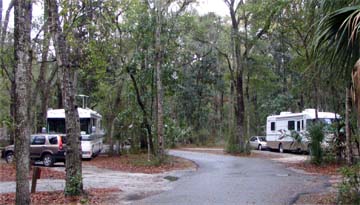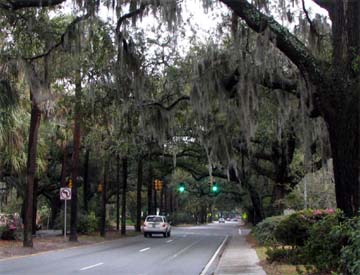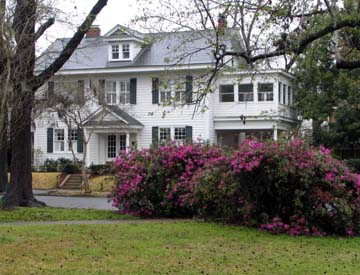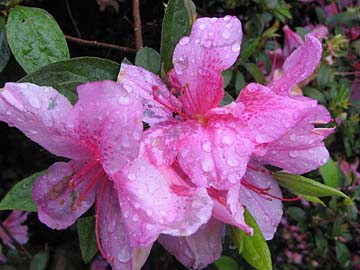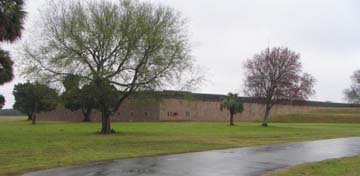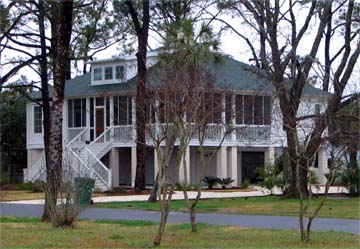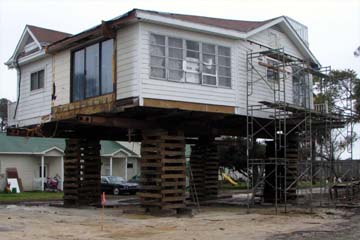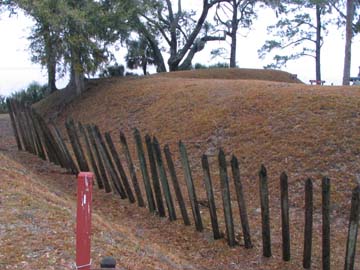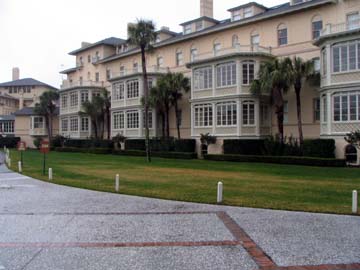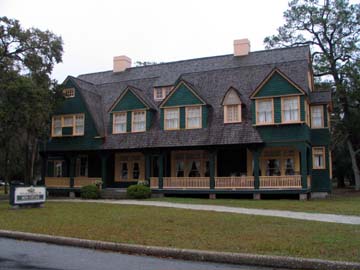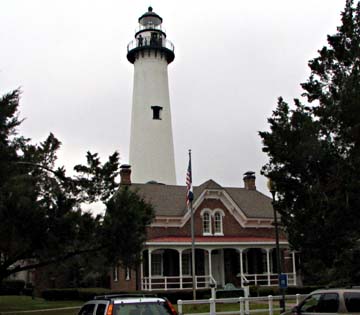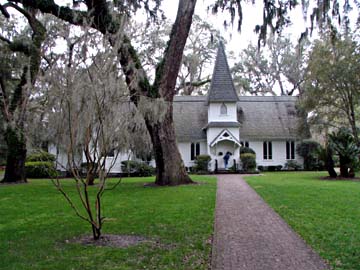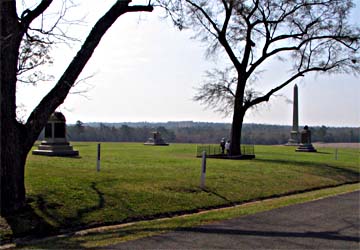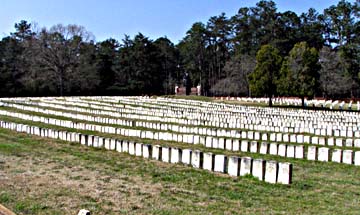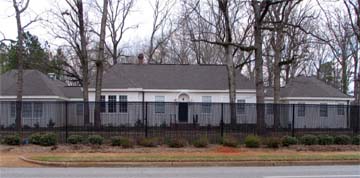)
Hi all,
Tuesday, Mar. 15
We left at 8 and arrived at the Fort McAllister State Park campground
about noon. This is in the Savannah area, but still a fair drive
into the city.
After getting settled, the four of us decided to drive into Savannah and look around. We found the visitor center and saw small trolley type busses from at least 4 or 5 companies offering tours of the city. They were priced from $19 to $25 each. We talked to Grey Line and found they have 1 wheelchair accessible trolley, and that we would have to call the office to find out where it was in the rotation, and get the timing from that. At the information counter we found that the city offers a shuttle bus around the city with a number of stops at no cost. We decided to try that. They use both a trolley type bus and a regular city bus for these tours, and all are wheelchair capable. We rode our city-type bus for about an hour and really saw much of the historical part of Savannah. It was an experience! The gal who was our driver sat on an air suspension seat, and as the bus bounced over the bumpy streets, she would bounce up and down 8 or 10 inches! She was fearless! She took corners at the same speed as the straightaways, barely cleared the parked cars, and had to drive over curbs to make some of the turns. There was one place where she needed to make a left turn in front of a small square, but it was one way. She had to make very sharp turns at each of the corners around the square on the very narrow street. She ran over the curb at each corner. Another place she made a left turn onto a narrow street. There was a car waiting on the other side of the street. She started her turn right in front of the car then waited. As the car backed up a little, she would pull up a little, until the car had backed up enough to let her complete the turn. What we saw on this trip was not at all what I had pictured Savannah to be. This was the urban downtown portion. There were some beautiful homes packed edge to edge to some that were not so beautiful. There were many shops and small businesses and a lot of narrow, car lined streets. We also passed some more spacious majestic old homes, some with very elaborate landscaping, some with none. Our bus did not go down by the river, which we would have liked to do, but found out later that they were barricading it off in preparation for the St. Patrick's Day Parade in two days. It was a lot of fun, and we got to see pretty much the whole "historic" section. Back at the motorhome, we watched the 5 o'clock news. The weather reporter stated that there was a 100% chance of rain starting about 7 tonight, and continuing all day tomorrow. He expects 1 1/2 inches. Thursday is supposed to be showery with a 50% chance of rain. I guess we cannot dodge the bullet indefinitely! It actually started to rain about midnight. Wednesday, Mar 16
On the way there, we passed through some beautiful neighborhoods that
were much more of what I thought Savannah would be like. There were
large trees totally canopied across the road, with moss dripping from the
branches. The flower beds were just starting to explode with color,
and the houses were reasonably separated with front lawns. There
were a lot of very historic looking brick houses, some natural color, but
many painted. The center medians of the highway were beautiful green
lawn with gorgeous flower beds of tulips, daffodils, and azaleas.
We wandered around several of these neighborhoods and ran into frequent
parks with yet more flowers. It drizzled on and off for our drive.
We reached the Fort Pulaski visitor center and were immediately offered the 30 minute video, giving the history of the fort. Construction of the fort was begun in 1829, and took 18 years to complete. Completion also took a million dollars and 25 million bricks. Arming and equipping it took many more years. As it turned out, the federal troops could not occupy the new fort until they conquered it. Two weeks after South Carolina seceded from the Union in 1860, but before Georgia did, the GA governor ordered the state militia to seize the fort. In early 1862, Union troops erected 11 artillery batteries with 36 guns
on nearby Tybee Island, which had been recently abandoned by the Confederate
troops. The Confederates were not worried about these guns, as they
were a mile away, almost twice the effective distance of the current smooth
bore cannon and their ball ammunition. What they did not know was
that the Union troops had brought 11 new experimental rifled-barrel guns
which shot pointed projectiles. The constant bombardment of these
long range guns opened dangerous holes in the near corner of the fort,
exposing the main powder magazines. The Confederate commander, Col.
Charles H. Olmstead decided to surrender the fort rather than risk losing
everyone if the magazines were hit. The total assault took less than
30 hours.
Unfortunately, the very act of taking the fort back, proved that it was already obsolete. We next drove to Tybee Island. Originally named for the Indian
word for "salt", it is now a beach resort with about 3 miles of sandy shoreline.
There are many houses, about half are elevated with only garages, storage,
and porches downstairs. We explored most of the island, finally arriving
at the original lighthouse. Unfortunately we arrived just before
5, and although it is open until 5:30, no tickets are sold after 4:30.
On our way home, we thought we would check out a well advertised place called the "Crab Shack" to see what they offered for dinner. We found the signs pointing to it and finally found it. The driveway in, as well as the parking lot right up to the entrance was slimy mud! We slogged in to where we could turn around and went right back out. I had blueberry pancakes at Cracker Barrel and Betty had a catfish fillet sandwich. Thursday, Mar. 17
Fort McAllister is a Civil War fort built by the Confederates with tall, very thick earthen walls all around and throughout the fort. There is a moat around the outside which is filled with a row of sharpened stakes, almost the size of telephone poles, set in the ground at about a 45 degree angle. The men's quarters and storage of most supplies and ammunition were all underground. The fort was under siege 8 times during the Civil War. It withstood the first seven with minimum damage. The cannon balls would not break the soft earthen walls, but merely be absorbed by them. Any damage could be repaired overnight by just shoveling the dirt and sand back into position. The fort finally fell when Sherman and his army attacked it by land. The cannons were all set to defend from an attack by water from the Ogeechee River. The men in the fort never did surrender, but were overrun by Sherman's men. Back at camp, we did our last minute get-ready routines and pulled out for Brunswick. It only took about an hour and a half to drive. We filled up at a Flying J and drove another half mile to our Passport America campground. This afternoon we all headed to Jekyll Island, then to St. Simon Island. Jekyll Island is very different from Tybee. This is not an obvious tourist trap like Tybee. There are some normal businesses, but mostly it is a residential island. The large initial difference we noted is that they charge an admission fee! It costs $3 per car to enter the island. The island was originally bought by F. H. Goodyear, Edwin and George Gould, J. P. Morgan, Joeseph Pulitzer, and William Rockerfeller for a sum of $125,000. They built a huge clubhouse and large "cottages" for use as a hunting preserve and family getaway. There are many nice, but normal homes on the island. Then there
are the millionaires' mansions! The Island Club is one of the largest
"clubhouses" I have ever seen!
In the early 20th century, it is said that the members of the Island Club represented 1/6 of the WORLD'S wealth! By World War II, most of the later generations of the members had lost interest in the island, and in 1947 the island was sold to the state of Georgia for use as a state park. Then we drove to St. Simon Island to "scope out" the locations of places we want to tour tomorrow. As it is still drizzling lightly and is still in the 40's, we wanted to stay in the car as much as possible today. Using a map with only sparce details of the island, we had "fun" finding the lighthouse, several churches, and Fort Frederica. Eventually, we found them all, and plan to return to several tomorrow. We unsuccessfully searched for a suitable seafood restaurant, and returned to our motorhomes. I decided to have seafood anyway, so I nuked a fish stick TV dinner. Not quite what I was looking for, but it was filling. Till next time, Dick and Betty (Report #4)
Hi all,
Friday, Mar. 18
We next drove to the other end of the island, stopping at Christ Church. Established in 1736, Charles Wesley was its first priest. It is a currently operating Episcopal church. There was a service scheduled at 11:30, 30 minutes after we arrived. We were allowed to go in and look around quickly. The grounds around the church are beautiful! There is a large lawn with mature trees and flower gardens everywhere. There are several sections of burial grounds around a couple sides of the church. John and Charles Wesley were the founders of the Methodist Church, and used to preach under the oak trees in the moat surrounding the town of Frederica. We continued down the road a short distance to the Fort Frederica National
Monument. In 1736, General Oglethorpe began the construction of one
of the most important British fortifications in America. The Spanish
were in Florida and were a threat to the Colony of Georgia. In conjunction
with the fort, he laid out the town of Frederica, which was populated with
carefully selected British subjects having the needed talents. After
the French were driven back in 1742, and a truce signed, Ogleghorpe's regiment
was disbanded in 1749. This ruined the economy of Frederica, and
many of the citizens left. In 1758, a fire destroyed what was left
of the town.
After a real seafood lunch, we drove up to the Hofwyl-Broadfield plantation. After its initial purchase in 1806, this land was made into a rice plantation. During its ownership by 5 generations of the same family the rice plantation alternately flourished and became debt ridden. When slaves were no longer available as a source of cheap labor, the plantation was converted into a dairy farm. This was finally closed down when new laws would have required the addition of expensive pasteurizing equipment. When the last of the heirs died shortly later, the business was finally debt free, and was willed to the Nature Conservancy, who in turn deeded it to the state of Georgia. Saturday, Mar. 19
The first 120 of so miles was on a 4 lane state highway, and had excellent roads. It passed through a number of small towns and one larger one, but we had 65 speed limits for most of the distance, and very light traffic. Once we reached I-75 for our last 80 miles, we almost stopped! Traffic was very heavy and slowed down a number of times. We pulled into a rest stop several miles into our I-75 stretch. Here we put on the window labels needed to enter the convention. Upon re-entering I-75 traffic was flowing quickly with no bunching up or slowing. After one false start we were directed to and parked in our spots. We are on a large grass area and are somewhat close to the activity area. As at previous rallys and conventions, we are within "touching" distance of 4 other coaches. When I build up enough ambition, I will go through the paperwork we just picked up and review the vendors who will be displaying here and the list of seminars to attend. Meanwhile, it's nap time! Sunday, Mar. 20
We pulled into the visitor center in Andersonville, not really knowing what to expect. We saw the movie describing the creation and life of the prisoner of war camp built by the Confederates in 1864, it housed 45,000 prisoners during its 18 month existence. This was far more than officials had expected. It was built to house 10,000 with an expected population of 6000. Food and water were very scarce, and disease and starvation were very common. In all, about 13,000 of the total of 45,000 died here. Even though the death rate was not much worse than other Confederate camps or the Union ones either, after the war, the commander of the camp was tried for war crimes. He was convicted, and hanged. The museum was a tribute to all prisoners of war of all wars. It had photos, videos, memorabilia, and displays of most of the nations wars and their prisoners. Leaving the museum, we drove around the area of the stockades.
We rented a CD tour which described what we were seeing as we drove the
route. The actual stockades are long gone, but markers abound showing
the location of the original walls, and then the enlarged area as the overcrowding
became severe. The water supply for all the prisoners was a small
muddy creek with a very small flow of water. The prisoners prayed
for relief, and one day there was a violent thunderstorm which brought
volumes of fresh, clean water. Lightning struck just inside the prisoner's
area and a spring gushed forth, saving many of the remaining survivors.
There were many attempts at escape, but few succeeded. Many tunnels were dug, but invariably the highly trained dogs would catch them before they could break for freedom. The 300 plus escapes that were made were mostly members of work parties eluding their guards, and some jumping parole. Some men were paroled, on the promise that they would return home and not rejoin the fighting forces. That didn't work, so the practice was stopped. One of the reasons there were so many prisoners was that the early practice of prisoner exchanges was stopped. The Union decided it was better to lose some of their own men to death and disease in the camps than to release Confederates to come back and fight. It was a very moving experience to see the movie and the actual location where it all happened! Next on the CD tour was the cemetery. This is where all those who died in camp were buried, and is an active military cemetery today. Due to a couple of exhumations elsewhere and re-burials here, there is now one Revolutionary soldier and one Confederate soldier buried here. Upon leaving Andersonville, we headed the twenty some miles to Plains. At the visitor center, the girl at the desk gave me a map and proceeded to show me where "Mr. Jimmy" was raised, where "Mr. Jimmy's" campaign headquarters were, and where "Mr. Jimmy" now lives. Plains is a small town of about 300 and it was interesting to tour.
His boyhood farm was a few small buildings including a house that couldn't
have had more than a couple of rooms. (We didn't go in.). His present
house is a very nice, quite large house behind a high wrought iron fence
which was covered with chain link fence. There is a small guardhouse
and closed entry gates. We also drove by the Baptist church where
he still teaches Sunday school.
By the time we were back near Perry, it was about 2:30 and we decided to eliminate the 2nd half of our planned double header. We will take our chances on the weather tomorrow and if it is bad, we will skip Macon and the air museum. When we returned to our motorhome, we found an invitation to a Foretravel Dealer Reception at 6 tonight. I think we will go. (Later)
Monday, Mar. 21
We just returned from the evening entertainment which was a big band performance, with a lot of member dancing. Tomorrow the convention officially starts and the exhibits will be open at 8:30. Till next time, Dick and Betty
|
||||||||||||||||||||||||||||||||||||||
|
Dick Mason, Prescott, AZ 3/21/05
|
